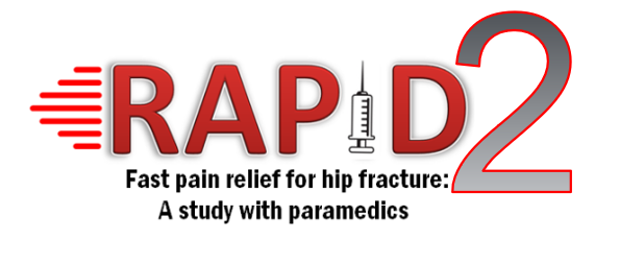 Title
Title
Randomised trial of clinical and cost effectiveness of Administration of Prehospital fascia Iliaca compartment block for emergency hip fracture care Delivery (RAPID 2)
Principal / Lead Investigator
- Professor Helen Snooks, Swansea University
- Dr Mark Kingston, Trial Manager, Swansea University. Email: m.r.kingston@swansea.ac.uk
Co-Investigators / Research Team
- Dr Jenna Jones, Swansea University
- Dr Sarah Black, South West Ambulance Services NHS Foundation Trust
- Dr Bridie Evans, Swansea University
- Dr Simon Ford, Swansea Bay University Health Board
- Ms Theresa Foster, East of England Ambulance Service NHS Trust
- Professor Steve Goodacre, The University of Sheffield
- Ms Sian Jones, Public Contributor
- Dr Leigh Keen, Welsh Ambulance Services NHS Trust
- Dr Mirella Longo, Cardiff University
- Professor Ronan Lyons, Swansea University
- Professor Ian Pallister, Swansea Bay University Health Board
- Dr Nigel Rees, Welsh Ambulance Services NHS Trust
- Professor Niro Siriwardena, East Midlands Ambulance Services NHS Trust
- Professor Alan Watkins, Swansea University
- Professor Julia Williams, South East Coast Ambulance Services NHS Foundation Trust
- Dr Helen Wilson, Royal Surrey County Hospital NHS Foundation Trust
Type of study
Randomised controlled trial
Summary
Background and study aims
Hip fractures are a very common injury for elderly people. About one in three patients who break their hip die within one year and many patients lose mobility and independence. Pain relief before the patient reaches hospital is often inadequate and causes side effects which may slow down recovery. We have recently completed a small study testing whether a local anaesthetic injection into the hip area called Fascia Iliaca Compartment Block (FICB) given by paramedics at the scene of injury is safe and acceptable. We met all the criteria that we set at the beginning of the study, and concluded that it is feasible to undertake a full trial.
Aim
We aim to find out whether the local anaesthetic injection reduces pain, is safe, and improves patient health outcomes, as well as how much it costs the National Health Service (NHS).
Who can participate?
Adult patients attended by a participating study paramedic following a 999 call who are assessed as having an isolated hip fracture.
What does the study involve?
We will carry out a trial where paramedics give patients either the new treatment - local anaesthetic injection or usual care (often morphine). Patients will be allocated to one or other treatment by a random process (similar to tossing a coin) to ensure a fair comparison between treatments. We will provide training for the paramedics who take part in the trial, so that they can perform the local anaesthetic injection safely. When a trained paramedic attends a patient he or she assesses as having a hip fracture, (s)he will use a scratchcard to decide which treatment to give the patient. We will compare patients’ pain levels, other outcomes and costs between those allocated to the new local anaesthetic injection and those allocated to receive usual care. The other outcomes we will compare between the two groups during their initial care and up to four months following injury are: length of stay in hospital, deaths, quality of life, ability to walk, and satisfaction with care. We will also monitor safety by identifying any concerning health-related events in each group. We will work out the costs of NHS care in each group.
Lay involvement
Two members of the public have helped us to plan this bid and two patient groups (approximately 40 individuals) reviewed our ideas. Members of the public will continue to be involved throughout this research. During the research, members of the public will attend meetings, help to write information sheets for patients, and help to write up the findings from this research. Members of the public will also sit on our oversight committee to ensure the research is carried out properly, and be part of local implementation teams at sites to ensure the patient voice is heard throughout our research.
How can this research potentially benefit patients?
The possible benefits of taking part are potentially receiving more effective pain relief at the time of hip fracture. The risks of taking part - there are some potential complications of the local anaesthetic nerve block, including infection or bruising at the site of the injection. Rarer complications include nerve damage and local anaesthetic toxicity. Although there are potential complications, current usual care (morphine) also has several known side effects including confusion, nausea, constipation and respiratory depression - the patient will avoid these side effects.
Funder
NIHR HTA
Total grant value
£ 1,818,109
Amount to Wales
To follow
Start date
01/12/2020
End date
31/01/2025
Outputs generated
- Kingston M, Jones J, Black S, Evans B, Ford S, Foster T, Goodacre S, Jones ML, Jones S, Keen L, Longo M, Lyons RA, Pallister I, Rees N, Siriwardena AN, Watkins A, Williams J, Wilson H, Snooks H. Clinical and cost-effectiveness of paramedic administered fascia iliaca compartment block for emergency hip fracture (RAPID 2)—protocol for an individually randomised parallel-group trial. Trials 23, 677 (2022).

